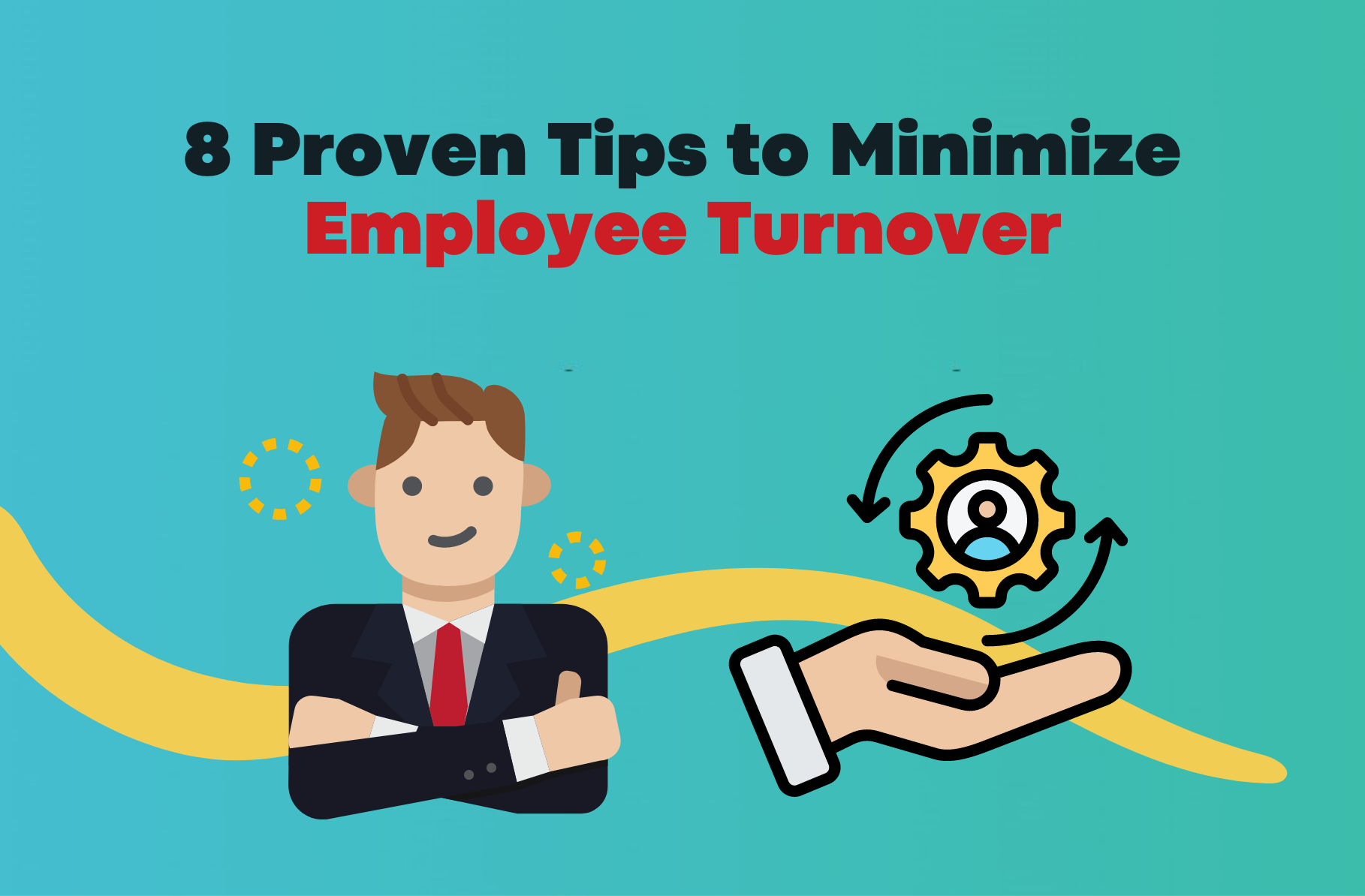We’ve recently been working with a recruitment company that has grown from 0 to 245 recruiters in just three years. And yet, many others struggle to get past 10 staff. In fact, even worse, many recruitment businesses expand to around 10 people only to then retract and end up starting again with the principle being the main breadwinner. In this article, we will share some proven solutions to avoid a revolving door in your recruitment company.
List of 8 Proven Tips to Minimize Employee Turnover
Here are the 8 Tips to Minimize Employee Turnover:
1. Recruit the Best Talent From the Start
This might sound obvious, but one effective strategy to reduce turnover and enhance employee retention rates is to adopt a forward-thinking approach from the very start. Make it your mission to only recruit the highest caliber recruiters and trainees into your business. If you subjectively rate the interviewee as 7 out of 10, consider turning that candidate down and work harder to find 9 out of 10 caliber individuals.
Tip: Create an interview score card that evaluates the key attribute of top recruiters. I’ve listed 3 important attributes that all recruiters process below.
- Drive
- Interpersonal effectiveness
- Self-management
By focusing your questions upon the hunger and attitude as well as their ability to influence/persuade, you’ll be able to objectively mark candidate interviews and compare them with other candidates that you see. If you’d like a copy of our recruiter interview scorecard, please WhatsApp us with your request and we’ll send it to you for free.
It goes without saying that it’s crucial to make sure that you’re recruiting individuals who align well with your organization’s culture. By meticulously evaluating candidates during the hiring phase, you increase the likelihood of selecting candidates who are a good fit, thereby reducing turnover potential in the future.
Identifying the most suitable candidates for your company involves clearly defining your organizational culture and effectively conveying it throughout the hiring process. Using various channels such as job descriptions, your company’s website, and social media platforms, you can express core values and desired characteristics that contribute to cultural alignment.
2. Focus on Employee Engagement
Managers should demonstrate care and respect towards employees, as feeling valued fosters loyalty and retention. If you look at employee engagement, most recruitment directors are aware of the value of money to attract good talent. They’re aware of the value of commission schemes, of bonuses, of incentives, of prizes. But they tend to default to those things. However, the real motivators and the things that make people go the extra mile and the things that retain people are employee engagement.
Employee engagement is proven widely. In the book “The Extra Mile: How to Engage Your People to Win” by David MacLeod, he surveyed 600,000 people around the world to find out what made people go the extra mile, and he broke down from that research the top 20 drivers of what keeps people happier in the workplace. One of the biggest ones is:

“My manager cares about me”
If employees think their manager cares about them, the manager gets loyalty. And with loyalty comes greater retention. That can be as simple as a weekly one-to-one meeting or the manager running micro-training sessions for their team.
Companies like Accenture massively bought into this, and they increased profitability, and increased retention hugely.
3. Arrange Micro-training Sessions
Provide continuous learning opportunities to prevent employees from feeling stagnant and unchallenged in their roles. Another big reason from David MacLeod’s research that shows what makes employees happier is:
“I’m learning new things on a continual basis”
If staff feel stagnated, then they’re probably going to leave. The job becomes less challenging. Because one thing is sure, change is constant, and if you’re not changing and improving, you’re going to get left behind. So you’ve got to upskill all the time. And one of the best things that we’ve helped our recruitment company clients with is implementing weekly micro training sessions. A 30-minute session once a week will put it in the DNA of the business. And this has shown very good retention of top people.
4. Publicly Recognize and Praise Employees
Regularly acknowledging and praising employees for their achievements and contributions, publicly when possible, is a great way to boost morale and job satisfaction. Referring back to the book, another top reason employees say why they like working at their job is:
“I get praise and recognition in the workplace”
Most managers and directors catch people doing things wrong, and it’s understandable because if someone makes a mistake, you’ve got to fix it. But it can be wearing. Another way of doing it is to catch people doing things right, praising it publicly. Go out of your way to praise it, and make sure that other people acknowledge your praise.
You can say things like:
- “Johnny, that’s a brilliant idea. I love it. Let’s go for it”
- “Guys, what does everyone think of Johnny’s idea?”
- “The company has got to implement that.”
Do it very deliberately as a manager because it serves a specific purpose; not just to praise him and make him or her and make them feel good, but to also spread the contagion of positivity around the rest of the team, as others may not have spotted the quality of the idea.
5. Value Employee Ideas
Encourage employees to share their ideas and involve them in decision-making processes, fostering a sense of ownership and contribution. To cite another reason from David MacLeod’s book “The Extra Mile: How to Engage Your People to Win,” employees stay and enjoy working at their company because:
“My ideas are valued”
That’s a big one. For the best managers and directors, their go-to place for ideas is their people. If they need ideas, they often call up a meeting and ask the teams for a brainstorming session. Create some excitement and buzz. Build a culture of creativity and innovation, where employees feel empowered to contribute ideas and solutions to drive the organization forward. It is a part of retention.
6. Build a Strong Team
Surround employees with high-caliber colleagues to challenge and motivate them, ensuring they feel supported and inspired in their work environment.
Managers should stretch their employees. People like to be stretched. Take one example from a great interview with Sir Alex Ferguson, who was the legendary Manchester United football manager. He was asked if he should treat young people differently in today’s world. His answer was, “Yes, absolutely. You’ve got to be harder on them”. And there’s a lot of truth in that. Good people need to be stretched. So if you’ve been stretched and you’ve been taken on to the next level, you’re learning all the time. It’s a challenge. You come into work every day, you’re not quite sure what’s going to happen, and therefore you’re more alert.

Everyone wants high quality people around them. Recruitment training expert Mike Walsmley, who has had over 30 years of experience in the recruitment industry, explained that he once left a company partly because there were some low caliber people working with him. He could almost predict what mistakes his teammates were going to make, and they did.
He realized he was surrounded by people who are not the right caliber. The mistake of that business was having low barriers to entry and they let people in who weren’t sharp enough, which made him want to leave. So if an employee is in a superstar team, they’ve got to be at the top of their game to go to the next level.
7. Set High Standards:
Establish a culture of excellence within the company, striving for continuous improvement and promoting a mindset of world-class performance.
People like high standards. Not only companies like Apple can be world class, you can be world class too. Let’s now break down everything we need to be world class as a business:
- Objection handling
- Business development
- Candidate sourcing
- LinkedIn posts
- Use of CRM
- Use of AI
- And many other things!
Itemize everything you need to be world class at, and then grade yourself as a business owner against those things. Now you’ve got a roadmap of where to improve. No one’s perfect, but if you can set your stall out, that you want to be a world class business, then remember that the best people will want to work for world class businesses.
If you accept shoddy performance, if you don’t hold people to account, if you accept deceitful behavior, if you accept cheating, people see that and they leave.
8. Promote Ethical Leadership:
Lead by example and uphold ethical standards, avoiding underhanded tactics or deceitful behavior that erode trust and drive away top talent. Leadership sets the tone from the top. If you’ve got weak leadership, people see it and they don’t want to work there. Weak leadership in a business can cause people to leave.
Mike Walmsley, now a well-known successful trainer, shared about another company that he left during his early years in the industry. His manager at the time wasn’t particularly good at business development. One day, she asked him to go to one of that company’s competitors and pretend to be a candidate and register with them, and see what information he can pick up.
Now, as a young guy, Mike had to follow what his manager told him. But after reflecting on it shortly afterwards, he found the whole operation to be very underhanded, that he was better than that, and he didn’t have to do it this way. Mike already knew better ways to find new business. So he left the company.
So, deceitful behavior, underhanded tactics, impact upon retention. The superstars don’t like it and they will leave.
Conclusion
In conclusion, prioritizing employee retention is absolutely important for the long-term success of any organization. By recognizing the value of their workforce and implementing effective strategies to retain top performers, companies can build a positive workplace culture and drive sustainable growth. However, it’s essential to address underlying issues that may hinder retention efforts, including management excuses that undermine employee satisfaction and engagement.
To go deeper into this topic and discover why you shouldn’t accept these management excuses, check out our article titled “You Can Lead A Horse to Water”: https://recruitmenttraining.com/you-can-lead-a-horse-to-water/
Explore how effective management can lead to a more engaged, motivated, and productive workforce, ultimately propelling your organization towards greater success.





